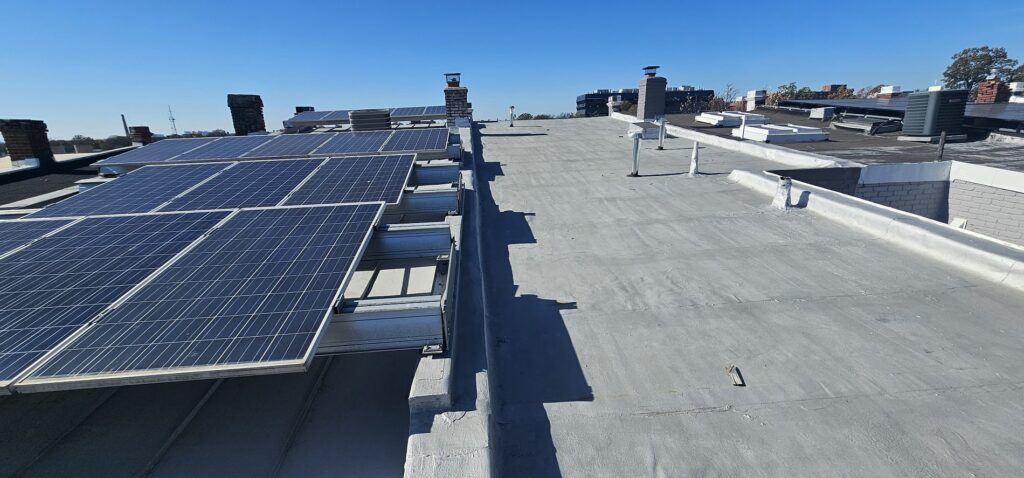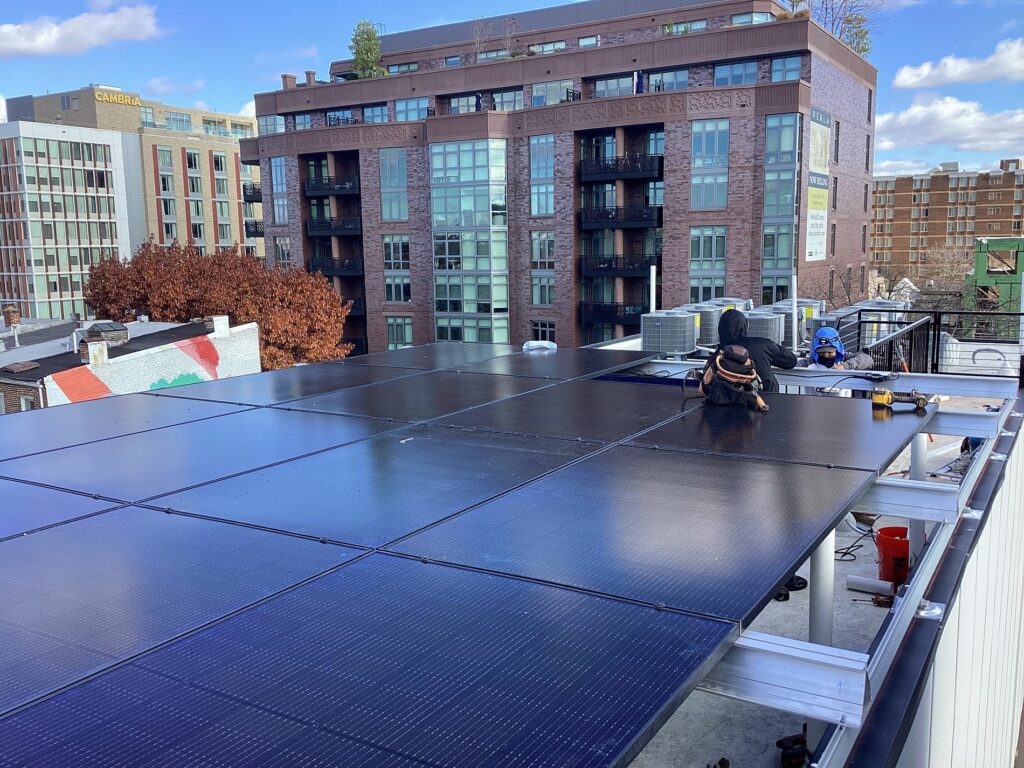As the transition towards renewable energy accelerates, understanding the interaction between solar panels and roof structures becomes imperative. This guide is a comprehensive exploration of solar panels and the integral role of roof repair in ensuring their optimal performance. It provides a detailed overview of the installation process, the impact on existing roofs, and the necessity of regular maintenance. Offering expert insights backed by rigorous data, this discourse equips readers with the practical knowledge needed to navigate the complexities of solar panel systems and roof repair. For homeowners and professionals alike, mastering these nuances is pivotal in maximizing the benefits of solar energy, both economically and environmentally.
Key Takeaways
- Solar panels offer numerous advantages, including reducing energy costs, increasing property value, and mitigating greenhouse gas emissions.
- The installation of solar panels on roofs can provide an additional layer of protection against environmental elements.
- Before installing solar panels, it is essential to evaluate the condition of the roof to ensure its structural integrity and durability.
- Different roof types, such as sturdy roofs with southern exposure and minimal shading, tilted roofs, metal roofs, composite shingle roofs, and flat roofs, can be suitable for solar panel installation.
Understanding Solar Panels Basics

Solar panel technology, a key component in sustainable energy solutions, involves the conversion of sunlight into electricity through photovoltaic cells. This technology, hinging on a process called the photovoltaic effect, is gradually becoming a household term. The photovoltaic cells, composed of semiconductor materials, absorb photons from sunlight. This absorption causes the movement of electrons in the semiconductors, ultimately creating an electric current. The efficiency of solar panels depends on the quality of photovoltaic cells and the intensity of sunlight. Therefore, strategic positioning of the panels is crucial. Understanding these basics is instrumental in integrating solar technology into residential and commercial spaces for sustainable energy consumption, and in managing potential impacts on roof structure and repair.
Advantages of Solar Panel Installation
It’s an investment that pays substantial dividends over time. Solar panels can significantly lower your energy costs by generating free electricity for your home. Additionally, solar installations increase the value of your property, making it a profitable long-term investment. From an environmental standpoint, solar energy reduces dependence on fossil fuels, mitigating greenhouse gas emissions. Furthermore, advancements in solar technology have led to more efficient and durable panels, providing reliable energy even in cloudy conditions. Lastly, many regions offer incentives for solar adoption, such as tax credits, making the transition to solar energy more affordable. Therefore, solar panel installation is a practical, cost-effective, and sustainable solution for energy generation.
What is The Impact of Solar Panels on Roofs?
Solar panels, by design, are robust and lightweight, hence, they do not exert undue stress. However, the installation process entails drilling into the roof structure which can potentially lead to leaks if not properly sealed. Advanced installation techniques have largely mitigated this risk. Long-term, solar panels actually preserve roof longevity by protecting it from environmental elements like sun, snow, and rain. However, they can complicate roof repairs or replacement due to the necessity of their removal and reinstallation. Thus, it’s advisable to ensure a roof’s condition prior to solar panel installation.
Evaluating Roof Condition Before Solar Panel Installation
A professional evaluation will determine the roof‘s ability to support the additional weight of solar panels and to withstand diverse weather conditions.
| Aspect | Evaluation |
|---|---|
| Structural Integrity | Assessed to ensure it can support the weight of panels |
| Material Durability | Checked for resistance to weather and aging |
| Remaining Lifespan | Estimated to match or exceed the solar system’s lifespan |
Identifying potential issues early can prevent costly repairs down the line. A sturdy, durable roof ensures the safety and efficiency of your solar panel system, giving you peace of mind and a sustainable energy solution.
Impact of Solar Panels on Roof Repairs
How do solar panels affect the need for and process of roof repairs? The installation of solar panels can have significant effects on the condition of your roof and the frequency of necessary repairs.
- Roof load: Solar panels add considerable weight to your roof, which can accelerate wear and tear. It’s crucial to have your roof inspected and possibly reinforced before installation.
- Access for repairs: Once installed, solar panels can make roof repairs more challenging. Panels may need to be removed and reinstalled, adding to the cost and complexity of roof maintenance.
- Weather protection: On the positive side, solar panels can protect your roof from weather damage by providing an additional layer of coverage.
Understanding these impacts can help you make informed decisions about solar panel installation and roof maintenance.
How Solar Panels Affect Roof Maintenance
The longevity of your roof is significantly influenced by the presence of solar panels, altering routine maintenance practices. Solar panels provide an extra layer of protection against environmental elements, potentially extending the lifespan of your roof. However, they could also complicate roof maintenance. While panels may lessen wear and tear from sun exposure, they could make it more challenging to spot and address roofing issues promptly. Furthermore, the installation process could cause minor damage if not performed correctly. Cleaning the panels is also a crucial part of maintenance to ensure optimal performance. It’s essential to hire professionals skilled in both solar panel installation and roof maintenance, ensuring the stability and longevity of your roof while harnessing solar power.
Solar Panel Installation: A Step-By-Step Guide
While it’s crucial to understand how solar panels can impact roof maintenance, it is equally important to know the proper steps for solar panel installation to ensure the longevity and functionality of both the roof and the panels.
Installing solar panels involves a detailed process:
- Site Evaluation and Measurement: An expert will assess your roof’s suitability for solar panels, taking into account its size, angle, and sun exposure.
- System Design and Planning: A solar system design is created, considering your energy usage and roof space. The design will include a layout of solar panels and other necessary equipment.
- Installation and Grid Connection: The solar panels are installed on your roof and connected to the grid.
Optimal Roof Types for Solar Panels
Generally, the most optimal roof types for solar panels are those that are sturdy, have a southern exposure, and minimal shading. Tilted, metal, and composite shingle roofs are among the best due to their durability and ease of installation. Tilted roofs allow for the right angle of incidence for sunlight, maximizing energy production. Metal roofs have a long lifespan, reducing the need for disruptive maintenance. Composite shingle roofs are common and straightforward for solar installment. Flat roofs require additional mounting hardware but can also be suitable. Each roof type presents unique considerations that should be analyzed to ensure optimal solar panel performance.
Navigating Roof Repair Post Solar Panel Installation
Post-installation maintenance becomes a paramount concern once the optimal roof type has been outfitted with solar panels. It is crucial to navigate roof repair effectively to maintain the functionality of the solar panels and the integrity of the roof. To do this successfully, you should:
- Regularly inspect the roof and solar panels for any signs of damage or wear.
- Schedule professional maintenance checks, preferably with a specialist knowledgeable in both roofing and solar technology.
- Have a plan of action ready in case urgent repairs are needed.
Lifespan of Solar Panels on Roofs
The durability of solar panels and their efficiency over time is a significant factor to consider when addressing roof repair and maintenance. On average, solar panels have a lifespan of 25 to 30 years, but this doesn’t mean they stop producing electricity after this period, it simply means their energy production is less efficient. Factors such as weather conditions, maintenance, and quality of installation can influence this lifespan. Solar panels are built to withstand various weather conditions, including high winds and hail. However, regular inspection and maintenance can help detect problems early and prolong their lifespan. When considering roof repair, it’s vital to assess the age and efficiency of the solar panels to make an informed decision.
Cost-Benefit Analysis: Solar Panels and Roof Repairs
Given the lifespan and durability of solar panels, it is crucial to conduct a comprehensive cost-benefit analysis when considering roof repairs and the potential impact on your solar installation.
To make an informed decision, consider the following factors:
- Initial Investment: Solar panels require a significant upfront investment. Be sure to factor in these costs when analyzing potential savings.
- Energy Savings: Solar panels can considerably reduce your electricity bills, especially in areas with high solar insolation.
- Maintenance and Repair Costs: Solar panels require minimal maintenance, but roof repairs might become necessary over time.
Helpful Tips for Solar Panel Maintenance

To prolong the lifespan of your solar panels, it is essential to carry out regular maintenance activities efficiently and effectively. Key to this process is routine cleaning. Solar panels operate at optimal levels when they are free of debris, which can block sunlight and reduce efficiency. Use a soft brush and mild detergent to gently clean the surface.
Another crucial aspect is regular inspections for damage. Hail, wind, or wear and tear can cause small cracks or faults, which can hinder the panel’s performance.
In addition, monitor your system’s energy output regularly. Sudden drops in energy production might indicate an issue. Always contact a professional if you notice any irregularities. Remember that proactive maintenance can save costly repairs and prolong the life of your solar investment.
Frequently Asked Questions
What Environmental Factors Can Affect the Performance of Solar Panels?
Environmental factors such as sunlight intensity, temperature, shading, and angle of installation significantly impact the performance of energy generation systems. These variables must be optimized for maximum efficiency and output.
How Do Weather Conditions Impact the Lifespan of Solar Panels?
Weather conditions significantly impact the longevity of solar technology. Extreme heat or cold, heavy rainfall, hail, and high winds can cause physical damage, reducing efficiency and eventually leading to the need for replacement or maintenance.
Are There Specific Roof Materials That Are Not Compatible With Solar Panels?
Yes, certain roofing materials aren’t compatible with solar panels. For instance, slate and cedar tiles are often too brittle. Meanwhile, rubber roofs may require specific mounting hardware to ensure a secure solar panel installation.
What Are the Potential Risks of Installing Solar Panels on an Older Roof?
Installing solar panels on an older roof can present risks such as structural damage from the weight of the panels, potential leaks, and costly repairs if the roof needs replacement after the panels are installed.
How Does the Weight of Solar Panels Affect the Structural Integrity of the Roof?
The weight of any added structure can impact the structural integrity of a base. In this case, heavy objects can exert stress on the roof, potentially causing damage if it’s not designed to handle such loads.
Conclusion
Solar panels provide a sustainable energy solution with significant economic and environmental benefits. However, their efficiency largely depends on regular roof maintenance and repairs. As solar power adoption increases, understanding the dynamics of solar panels and roof repair becomes more pertinent. Therefore, hiring a professional for roof repair services is essential to ensure the longevity of installed solar panel systems, ultimately contributing to sustainable energy development and climate change mitigation.